英语人教版九年级全册9年级英语第7单元教案设计
- 格式:doc
- 大小:50.00 KB
- 文档页数:10

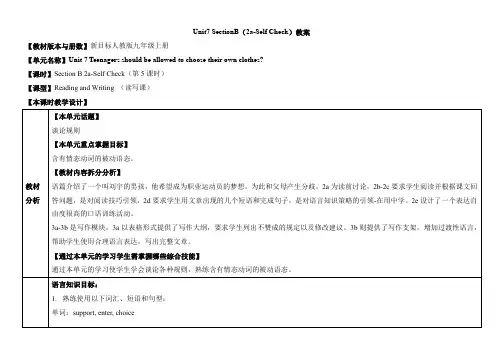
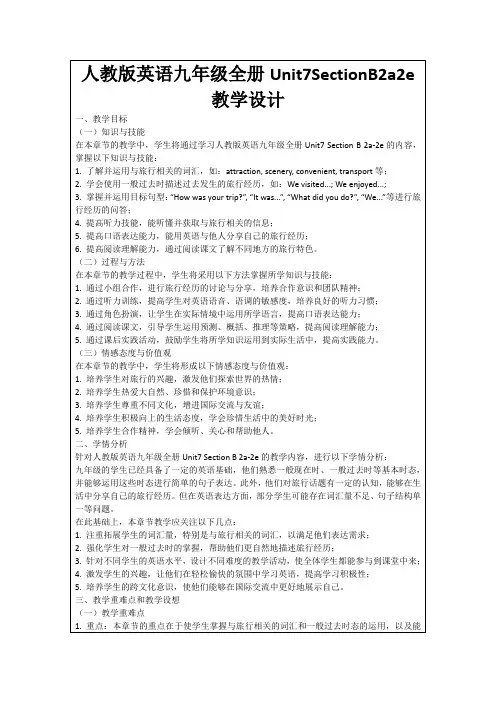
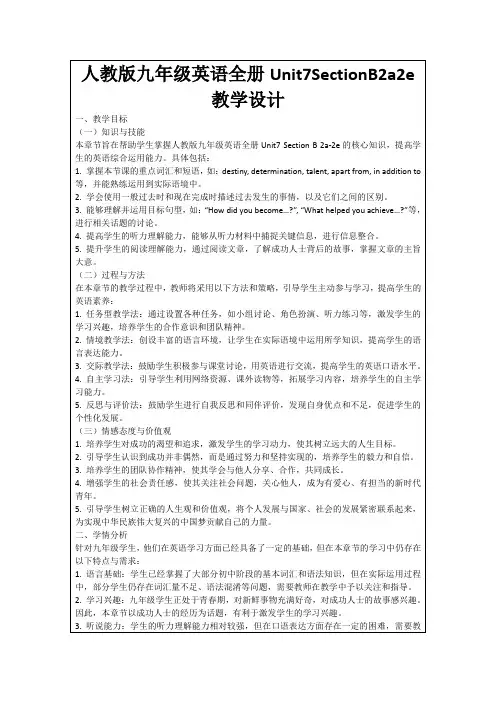
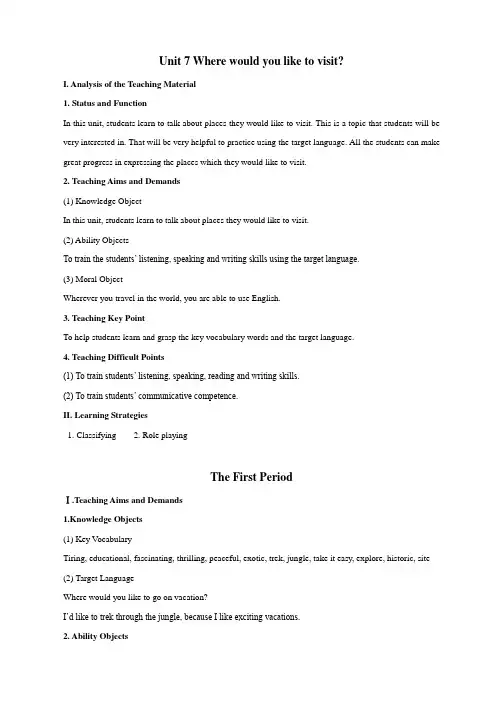
Unit 7 Where would you like to visit?I. Analysis of the Teaching Material1. Status and FunctionIn this unit, students learn to talk about places they would like to visit. This is a topic that students will be very interested in. That will be very helpful to practice using the target language. All the students can make great progress in expressing the places which they would like to visit.2. Teaching Aims and Demands(1) Knowledge ObjectIn this unit, students learn to talk about places they would like to visit.(2) Ability ObjectsTo train the students’ listening, speaking and writing skills using the target language.(3) Moral ObjectWherever you travel in the world, you are able to use English.3. Teaching Key PointTo help students learn and grasp the key vocabulary words and the target language.4. Teaching Difficult Points(1) To train students’ listening, speaking, reading and writing skills.(2) To train students’ communicative competence.II. Learning Strategies1. Classifying2. Role playingThe First PeriodⅠ.Teaching Aims and Demands1.Knowledge Objects(1) Key V ocabularyTiring, educational, fascinating, thrilling, peaceful, exotic, trek, jungle, take it easy, explore, historic, site (2) Target LanguageWhere would you like to go on vacation?I’d like to trek through the jungle, because I like exciting vacations.2. Ability Objects(1)Train students to talk about places they would like to visit with the target language.(2)Train students to describe vacations with different adjectives. (3)Train students’ listening skill.3. Moral Object, It′s more interesting to go on vacating somewhere instead of staying at home.Ⅱ. Teaching Key Points1. Key VocabularyTiring, educational, fascinating, thrilling, peaceful, exotic, trek, jungle, take it easy, explore, historic, site 2. Target Language Talk about different places with the target language.Ⅲ. Teaching Difficult Points1. Describe vacations with different adjectives.2. Talk about different places with the target language. IV. Teaching ProceduresStep Ⅰ Revision Revise the language points in Unit 6.Step Ⅱ 1a1. Introduce the key vocabulary.2. Show the new vocabulary words on the blackboard:tiring ad.引起疲劳的;累人的educational ad.教育的;有教育意义的fascinating ad.迷人的;有极大吸引力的thrilling ad.令人激动的;令人震颤的peaceful ad.平静的;宁静的;和平的exotic ad.外(国)来的;外国产的trek v.(缓慢或艰难地)旅行;长途跋涉jungle n.热带丛林;密林take it easy 从容;轻松;不紧张explore v.探险;考察historic ad.历史上著名的;历史上有重大意义的site n.地方;场所3. Point to the words and teach students to read them several times till they can pronounce the words fluently and correctly.4. Read the instructions to the students. Be sure that everyone knows what to do.5. Tell students to look at the posters in the picture and compare them.6. Ask students to say what place they would like to visit and why they want to go there.Step III SummaryIn this class, we’vet learned so me adjectives that are used to describe vacations and some other words. We have also learned the target language—Where would you like to go on vacation? I’d like to trek through the jungle because I like exciting vacations.Step IV Homework1. Try to remember the new key vocabulary.2. Finish the exercise of period 1.Step V Blackboard DesignUnit 7 Where would you like to visit?Section APossible answers to Activity 1a:Vacation 1: relaxing, peaceful, boringVacation 2: exciting, tiring, dangerous, educational, fascinating, interesting, fun,thrilling, exoticVacation 3: exciting, educational, peaceful, interestingThe Second PeriodⅠ. Teaching Aims and Demands1. Knowledge Objects(1) Key V ocabulary Fall, Niagara Falls(2) Target Language Where would you like to visit? I’d like/hope to visit/see…I’d like/love places where…2. Ability Objects(1)Train students’ listening skill.(2) Train students’ communicative competence.3. Moral Object It can make you know more about the world to travel much.Ⅱ. Teaching Key Points1. New words fall, Niagara Falls2. Listening practice with target language3. Make communications with target languageⅢ. Teaching Difficult Points1. Train students’ l istening practice with target language.2. Help students to make communications with target language.Ⅳ. Teaching Methods1. Listening2. Pair works3. ExplanationⅤ. Teaching Aids1. A tape recorder2. Some pictures of Hawaii, Mexico and Niagara FallsⅥ. Teaching ProceduresStep Ⅰ RevisionRevise the target language by askingStep Ⅱ Grammar FocusPresent ate the conversation below by saying to the students and writing it on the blackboard:Where would you like to visit?I’d like to go somewhere relaxing.Draw a line under the word relaxing.Then ask the children the same questions and tell them to answer in their own words. For example,I’d like to go somewhere interesting.After asking several students to give answers with different adjectives, get them to practice in pairs. Each pair makes two conversations.Next ask several pairs to share their conversations with the class.Then say, the adjectives usually come before the nouns, such as, an educational vacation, a tiring trip. But in the sentences which are using the word something or somewhere, the adjective should be put after the pronouns. For example:I’d like to go somewhere fascinating.I’d love to eat something delicious.Step III SummaryIn this class, we’vet done some listening practice with target language. We have also practiced our oral English in pairs. And we’vet discussed something on grammar.Step IV HomeworkMemorize the new words of unit 7 and finish some exercise.Step V Blackboard DesignUnit 7 Where would you like to visit?Section AGrammar Focus:1. Where would you like to visit? I’d like to go somewhere relaxing.2. Where would you like to visit? I hope to go to France some day.The Third PeriodⅠ. Teaching Aims and Demands1. Knowledge Objects(1) Key V ocabularyTouristy, spotlight" Singapore, beautiful, heavy, private, downtown, get around, pack, light(2)Target LanguageWhere would you like to go, Kathy? I’d like to vis it Kunming.2. Ability Objects(1) Train students’ reading skill.(2) Train students’ skill of communication.3. Moral ObjectShare your experience on traveling in a city with your classmates and tell them what they should bring if they decide to visit it.Ⅱ. Teaching Key Points1. Guide students to read the passage in Activity 3a.2. The new vocabularyⅢ. Teaching Difficult PointHelp students to talk to their partners about the cities they know.Ⅳ. Teaching Methods1. Teaching by illumination.2. Teaching by asking questions.Ⅴ. Teaching Aids1. A projector2. A video tape on Singapore or some photos, some photos of DalianⅥ. Teaching ProceduresStep Ⅰ Revision1. Revise the target language they learned last class by asking where would you like to go on vacation? Get several children to answer I’d like to…because…2. Check the homework by asking some children to read the conversations they wrote to the class.Step Ⅱ 3aThis activity provides reading practice using the target language.Introduce the key vocabulary words. Show the key vocabulary words on the screen by a projector.touristy ad.游客很多的;游客常去的;适合游览的spotlight n.公共注意中心get around 观光;到处走动pack v.把……打包;把……装箱light ad.轻的Teach students to read the vocabulary several times until they can read them out easily and correctly. Read the passage quickly and try to answer the questions on the blackboard.Write these questions on the blackboard:1. What does Paris have?2. How do you think of Paris?A few minutes later (maybe two or three minutes), ask different students to answer the questions.Next, analyze and translate the text for students, including some language points..Step Ⅲ 3bThis activity provides reading, listening and speaking practice using the target language.Read the instructions to students. Make sure that they know what to do.Step Ⅳ SummaryIn this class, we’vet learned something about Paris, and we’vet talked about some other places all over the world.We’vet done a lot of listening, speaking, reading and writing practi ce using the target language.Step V Homework1.Write a short passage on the city you talked about in class.2. Try to remember the new words on page 54.Step VI Blackboard DesignUnit 7 Where would you like to visit?Section AQuestions to Activity 3a:1. What does Paris have?2. How do you think of Paris?The Fourth PeriodⅠ. Teaching Aims and Demands1. Knowledge Objects(1)Key V ocabulary Customer, save money, pool, culture, dream vacation, travel agency(2)Target Language Where would you like to go? I’d like to go somewhere warm.2. Ability Objects(1)Train students’ listening ability.(2) Train students to use the target language in oral English properly.3. Moral ObjectTo role play t he conversations you’vet heard is a very good way to improve your oral English.Ⅱ. Teaching Key PointTrain students’ listening skill by listening to the conversations with the target language.Ⅲ. Teaching Difficult PointHelp students to role play the conversations.Ⅳ. Teaching Methods1. Brainstorm2. Listening method3. Pair worksⅤ. Teaching Aid A tape recorderⅥ. Teaching ProceduresStep Ⅰ RevisionStep Ⅲ 3aThis activity provides reading practice using the target language.At first, introduce the key vocabulary words. Show the key vocabulary words on the screen by a projector. provide v.提供;供给firm n.公司offer v.提供;给予spot n.地点;场所Confucius 孔子(公元前551~前479年,春秋末期思想家,教育家) stele n.(pl.steal)石碑;石柱forest n,森林;森林地带The forest of steles 碑林(位于陕西西安)Teach students to read the words and expressions several times. Then ask several to read to the class. Make sure that they can read the words fluently and correctly.Read the instructions to students. Do some explanation. Make sure that each student knows what they will have to do.Go over the statements about the e-mail message with the whole class. Make sure that they can understand all the six sentences in the box. And tell them to put the six statements in their minds while they scan the e-mail below.Ask students to scan the e-mail in Activity 3a now. Try to get the main idea of the letter and find out the answers to the statements. Ask them to scan the letter individually, and write T, F or DK before each statement.After they have all finished scanning, check the answers with the whole class. Elicit why the false sentences are false at the same time.After checking the answers, tell the children to read the passage more carefully and prepare to answer the questions on the blackboard.Write the questions below on the blackboard:1. Where do S.T. Zhang and the family want to take a trip? (Somewhere in the east of China.)2. What kind of place do they want to go to? (An exciting place where they can do lots of exercise.)3. What exercise do they especially love doing? (They especially love hiking and swimming.)4. What does S. T. Zhang say about the hotel they want to live in?(They need to stay in an inexpensive hotel. And they wish their hotel had rooms with kitchens so that they could save money by cooking their own meals. The room needs to be big enough for three people. And they’d like to stay at a place with a big pool or somewhere near the ocean.)5. What does S. T. Zhang want the travel agency to do?(Give them some suggestions for vacati on sports and let them know if it’s best to travel by plane, train or bus.)6. How long would they like to be away? (About three weeks.)After they have all finished reading, get some students to answer these questions.Encourage them to ask questions on what they don’t understand about the e-mail.Ask one student to read the letter to the class. Help him or her with the pronunciation. Then let all the students read the passage several times.Answers1. F (the family wants an inexpensive hotel and wants to save money by cooking)2. F (the: family enjoys hiking and swimming)3. DK4. DK5. T6. F (the person wants to go to the east of China)Step Ⅳ Homework: memorize the new words of unit 7 and finish the exerciseStep Ⅴ Blackboard DesignUnit 7 Where would you like to visit?Section BQuestions on the e-mail in Activity 3a:1. Where do S.T. Zhang and the family want to take a trip?2. What kind of place do they want to go to?3. What exercise do they especially love doing?4. What does S.T. Zhang say about the hotel they want to live in?5. What does S. T. Zhang want the travel agency to do?6. How long would they like to be away?The Fifth PeriodⅠ. Teaching Aims and Demands1. Knowledge Objects(1) Key V ocabulary Provide, firm, offer, spot, Confucius, stele, forest, The Forest of Steles(2) Reading practice using the target language (3) Writing practice using the target language2. Ability Objects(1)Train students’ reading skill.(2) Train students’ writing skill.(3) Train students’ listening a nd speaking skills.3. Moral ObjectAre you planning to take a trip this summer?Write an e-mail to a travel agency in English to get some information on vacations.Ⅱ. Teaching Key Points1. The new vocabulary.2. Read an e-mail.3. Write an e-mail.Ⅲ. Teaching Difficult Point Write an e-mail.Ⅳ. Teaching Methods1. Scanning the e-mail to find out the answers2. Writing3. Group workⅤ. Teaching Aids1. Some pictures of Queue, the Great Wall and the Forest of Steles in Xi’anⅥ. Teaching ProceduresStep Ⅰ Revision1. Revise the conversation in Activity 2c on page 55 by making a conversation with one student like this, T: Where would you like to go? S s: I’d like to go somewhere relaxing.T: What else can you tell me? S: I don’t want to go to b ig noisy cities.After that, ask them to practice in pairs.Step Ⅱ PartThis activity focuses on vocabulary introduced in the unit. Focus attention on the box. Invite a student to read the vocabulary words at the top.You are asked to fill in the blanks with the words. In some cases, you may need to use another form of the word, for example, adjusting for tense or subject/verb agreement.Ask students to fill in the blanks on their own.Check the answers. Five students each read a sentence, filling in the blanks. The rest of the students check their work.Collect a few students’ answers with mistakes on the blackboard. Along with the students help correct the mistakes.Step ⅢThis activity provides reading and writing practice using the target language.Read the instructions to the class. Get them to look at the pictures. Say, Can you say out the English names of the four famous places in the pictures?Ask some students who know that to tell the names. Write the four names on the blackboard: the Golden Gate Bridge in San Francisco, the Sydney Opera House, Big Ben in London, and the Eiffel Tower in Paris. Then teach them to read the names several times till they can read them fluently and correctly.After practicing the names, ask, which these places would you like to visit most? Why? Ask two or three students to tell their answers to the class. They may say like this,I’d like to visit Paris most. Because I cam see the famous tower, the Eiffel Tower. There. And I have ever heard the people there are very romanti c. I’m interested in that.Then say, please say something on the place where you would like to visit most to your partner now. Get them to work in pairs. Move around the room as they work, offering words and sentences as needed.After they’vet all finished, tell them to write an article about where they would like to visit most and why. Ask students to complete the work on their own. Move around the classroom and help them.After they’vet finished writing, ask a few students to read their articles to the cl ass. Encourage the rest of the class to tell the mistakes they may have made in their passages.Work in pairs. Each one reads their own passage to the partner. Help correct any mistakes in the passage. Step Ⅳ SummaryIn this class, we’vet practiced using some words. We’vet done some exercises on writing, too.Step Ⅴ Homework1.Rewrite the e-mail which you wrote in class.2. Try to remember the new words and expressions on page 56.Step Ⅷ Blackboard DesignUnit 7 Where would you like to visit?Self checkAnswers to Activity 1:1. Provide2. Cook3. Saving4. Pack5. hopeThe Sixth PeriodRevision1. Review all the language points in this unit.2. Finish off the exercises of the workbook.3.Rewrite the passage in Activity 2. Try to make sure each sentence is correct. Blackboard DesignUnit 7 Where would you like to visit?ExerciseTeaching reflection:。

Unit 7 Teenagers should be allowed to choose their own clothes.The First Period Section A 1a–2cTeaching aims(教学目标)口、笔头掌握句型1. A: I don’t think sixteen-year-olds should be allowed to drive.B: I agree. They aren’t serious enough at that age.2. A: Do you think teenagers should be allowed to choose their own clothes?B: Yes, I do. / No, I don’t.13. Sixteen-year-olds should be allowed to get their ears pierced.4. He should stop wearing that silly earring.5. Students must not be allowed to have part-time jobs.熟练掌握词汇:smoke, license, safety. 了解下列词汇:pierce, earring技能目标:能用should/should not be allowed to do谈论应该被允许和不应该被允许做的事情。
情感态度:勇于发表自己的观点和意见,表达同意或不同意。
Difficulties(难点):be (not) allowed to doTeaching steps(教学步骤)21. Warm-up and revision(课堂热身)Show pictures of “Where are dads going?”Kid: Can I drive my friends to the mall?Dad: No, you are not allowed to drive.教学设计说明: 通过情景对话复习情态动词can并且引进新知be( not) allowed to2. Presentation(呈现新知识)呈现王磊和多多的对话练习句型结构3A:Teenagers should not be allowed to smokeB: I agree.教学设计说明:操练句型结构3. Work on 1a.T: Read the statements below. Circle A for agree or D for disagree.1. Teenagers should not be allowed to smoke.2. Sixteen-year-olds should be allowed to drive.3. Students should not be allowed to have part-time jobs.4. Sixteen-year-olds should be allowed to get their ears pierced.45. Teenagers should be allowed to choose their own clothes.4. Work on 1b.T: Listen and circle T for true or F for false.•Anna can go to the shopping center by bus.•Anna wants to get her ears pierced.•Anna wants to choose her own clothes.T:Listen again and complete the conversation.• A. be allowed to choose their own clothes• B. shouldn’t be allowed to get their ears pierced5• C. should be allowed to driveAnna: Mom, can I go to the shopping center with John? He just got his driver’s license. Mom: No way! I don’t think sixteen-year-olds ___________. I’m worried about your safety. Anna: But Gaby’s getting her ears pierced at the shopping center and I want to watch. Mom: Sixteen-year-olds __________________ either. They’re too young.Anna: I agree, but it’s fun to watch. Can I take the bus then?Mom: Well, OK.Anna: Great! I want to buy a new skirt, too.Mom: What kind of skirt? Maybe I should go with you.6Anna: Aww, Mom. I’m not a child. I think teenagers ____________________.Mom: Well, I just want to make sure you get something nice.观察与思考:请观察听力原文中的填写句子。
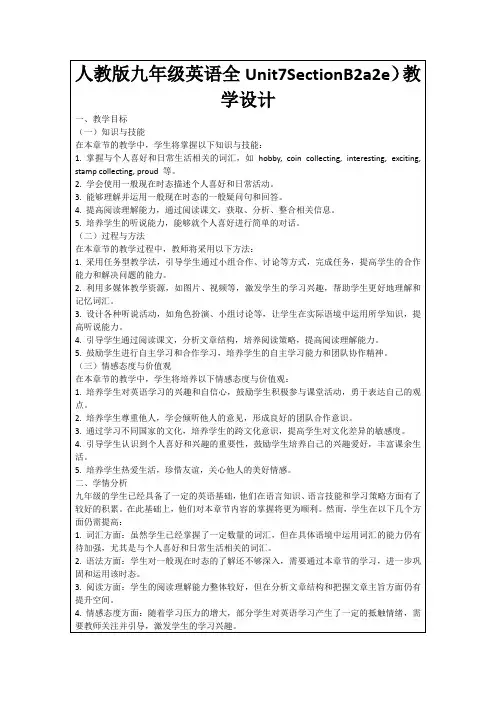
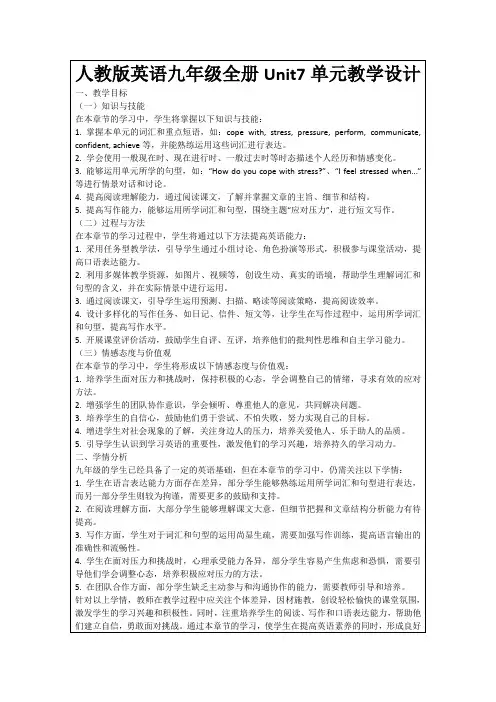


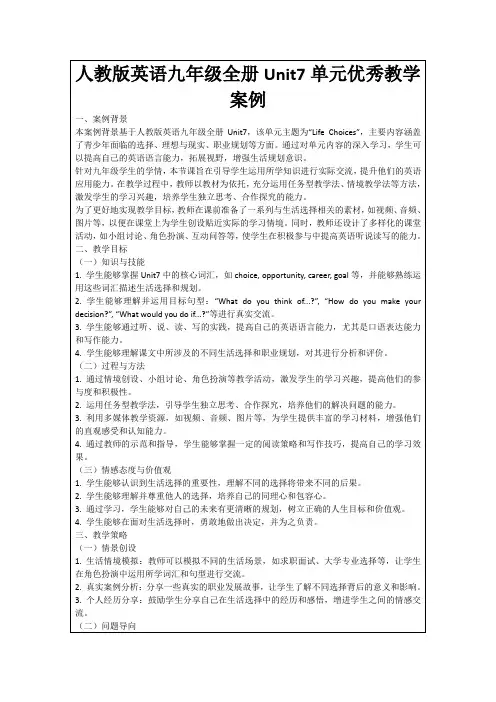
Unit 7Teenagers should be allowed to choose their ownclothes.Section A (1a-2d)1.重点单词:license,safety,smoke,parttime,pierce,earring,flash2.重点短语:sixteen-year-olds3.重点句式:I don't think sixteenyearolds should be allowed to drive.I'm worried about your safety.Anna wants to get her ears pierced.I'm really excited about seeing the famous paintings by Picasso.Do you think we may be allowed to take photos if we don't use a flash?1.重点短语和句型2.含有情态动词的被动语态1.重点短语和句型2.含有情态动词的被动语态一、预习课本P49-50新单词并背诵,完成下面的汉译英。
1.证件________ 2.安全________3.吸烟________ 4.兼职的________5.刺破________ 6.耳环________7.闪光灯________二、认真预习1a-2d找出下列句型。
1.我认为16岁的青少年不应该被允许开车。
_______________________________________________________ _________________2.我担心你的安全。
________________________________________________________ ________________3.安娜想打耳孔。
Unit 7 Teenagers should be allowed to choose their own clothesGrade level: 9th GradeCourse: EnglishTextbook: New Standard English, Book 9, published by People's Education Press.Objectives:To introduce students to the topic of freedom of expression and individuality.To help students improve their reading, writing, listening and speaking skills in English.To encourage students to think critically and express their opinions effectively.To enhance students' understanding of cultural differences and the importance of respecting others' perspectives.Materials:Textbook: New Standard English, Book 9, published by People's Education Press.Whiteboard or blackboard and markers.Handouts with comprehension questions related to the reading.Audio or video materials related to the topic.Pictures of different types of clothing and styles.Procedure:I. Warm-up activityThe teacher begins the lesson by asking students about their favorite type of clothing and why they like it.The teacher then asks students if they think it is important for teenagers to be allowed to choose their own clothes.II. Pre-reading activityThe teacher presents some pictures of different types of clothing and styles and asks students to discuss which ones they like and why.The teacher then divides the class into groups and asks them to discuss the pros and cons of having a dress code at school.III. Reading comprehensionThe teacher asks students to read the text "Teenagers Should Be Allowed to Choose Their Own Clothes" from their textbook.The teacher then distributes handouts with comprehension questions related to the reading and asks students to answer them individually.The teacher then discusses the answers with the class.IV. Vocabulary buildingThe teacher asks students to find some new words or phrases from the reading, and to write them on the board.The teacher then asks students to work in pairs and use the new vocabulary words in sentences.V. Listening comprehensionThe teacher plays an audio or video clip related to the topic, and asks students to listen carefully. The teacher then distributes handouts with comprehension questions related to the clip and asks students to answer them.VI. Writing activityThe teacher asks students to write a persuasive essay about why teenagers should be allowed to choose their own clothes.The teacher then asks students to exchange their writing with a partner, and to provide feedback on each other's writing.VII. Follow-up activityThe teacher concludes the lesson by asking students to share their opinions about the importance of freedom of expression and individuality, and how they think this applies to clothing choices.Assessment:The teacher can assess students' performance through the following:Observing their participation in class discussions and group activities.Reviewing their answers to comprehension questions.Assessing their writing activity and providing feedback.Observing their use of new vocabulary words in sentences.Homework assignment for "Teenagers Should Be Allowed to Choose Their Own Clothes" lesson:Write a persuasive essay arguing for or against having a dress code at school.Find a news article or opinion piece about a recent controversy related to clothing and dress codes, and write a summary of the article and your own opinion on the issue.Interview a family member or friend from a different culture about their attitudes towards clothing and fashion, and write a reflection on what you learned.Choose a celebrity or fashion icon and research their style and fashion choices. Write a short biography of the person and discuss their impact on fashion trends.Watch a documentary or video about the history of fashion and write a summary of what you learned.Write a journal entry reflecting on your own personal style and how it reflects your individuality.Practice reading aloud the text "Teenagers Should Be Allowed to Choose Their Own Clothes" from your textbook, paying attention to your pronunciation and intonation.。
Unit 7 Teenagers should be allowed to choose their own clothes.I. Learning objectives 教学目标II. Teaching materials analyzing and rearranging教材分析和重组1.教材分析本单元以Teenagers should be allowed to choose their own clothes 为话题,共设计了四个部分的内容:Section A该部分有4个模块:第一模块围绕What should teenagers be allowed to do? 这一话题展开思维(1a)、听力(1b)、口语(1c) 训练;第二模块围绕“agrees” and “disagrees”进行听力(2a-2b)、口语(2c) 训练,并就所学语言结构进行总结(Grammar Focus);第三模块就“about following the rules”这一话题展开阅读训练(3a)和角色表演训练(3b) ; 第四模块继续就上一话题以小组活动形式展开讨论。
Section B该部分有4个模块:第一模块是词汇的学习(1a)与运用(1b);第二模块围绕“One of the schoolrules”进行听力(2a—2b)、口语训练(2c) ;第三模块继续围绕The rules in school 这一话题展开阅读(3a)和角色表演训练(3b) ;第四模块就如何Make a list of rules以写作形式展开训练。
Self Check该部分有2个模块:第一模块以填空形式对所学词汇进行训练;第二模块就一封信围绕“agree or disagree” 进行阅读和写作的训练。
Reading该部分共设置了5项任务:第一项任务以小组问题讨论的方式激活学生相关背景知识;第二项任务让学生通过阅读获取信息;第三项任务利用造句、寻找信息、讨论等练习形式加深学生对阅读内容的理解;第四项任务要求学生能运用所学知识解决实际问题;第五项任务要求学生完成介绍名人童年生活及成功之路的任务。
2. 教材重组和课时分配Period I (Section A: 1a, 1b, 1c, 2a, 2b, 2c) New function presenting Period II (Section A: 3a, 3b, 4) PracticePeriod III (Section B: 1a, 1b, 2a, 2b, 2c) Integrating skillsPeriod IV (Section B: 3a, 3b, 4, Self Check 1, 2 & Workbook) ReadingPeriod V (Reading: Section 1—Section 4) Extensive ReadingIII. Teaching procedures and ways 教学过程与方式Period I New function presentingLanguage goals 语言目标1. Words & expressions 生词和短语allow, drive, pierce, driver, license, silly, earring, instead of2. Key sentences重点句子I think students should be allowed to go out with their friends. (P18)I agree. / I disagree. (P19)Do you think sixteen-year-olds should be allowed to work at night? (P19)Ability goals能力目标Enable the students to talk about things they are allowed to do and show “agree or disagree.”Emotion & attitude goals 情感和态度目标Enable the students to understand some strict rules they have to follow.Strategy goals策略目标Reflecting. .Culture awareness goals文化意识目标Follow the rules reasonably.Teaching important 教学重点Talk about what they are allowed to do; agree and disagree.Teaching procedures and ways教学过程和方式Step 1 Revision and Lead-inAsk one or more students to show their work.T: (Greet as usual) In the last unit, we learned how to write an e-mail to friends. Can you tell me what you often write in your e-mails?S: We often write about our problems, our puzzles, sometimes our happiness and achievements to each other.T: How often do you surf the Internet?S: Once a week.T: If your parents don’t allow you to surf the Internet and you can’t write e-mails to your friends, what will you do?S: I won’t be happy. Perh aps I will get annoyed with them.T: Well. That means you have your rules in your family though you are unhappy.S: That ’s right.T: We need to communicate with our friends and parents. If you have different opinions with your parents, how can you commun icate with them? We also have to obey our parents. This class we’ll talk about what teenagers should do in our daily life.T: Now I’d like you to see a picture.Show the picture.T: The students in the picture are from Chongqing. They’re having adebatingon the topic “What should teenagers be allowed to do?” Because they thinkthe topic is meaningful among teenagers. You are old enough to make clearwhat to do and what not to do. Only after you understand and follow therules can you become useful people with a lot of abilities to our society. Most of middle-school students thinkthey should be allowed to do all the things they like, for example, they think:They should be allowed to — choose their own clothes—go out with their friends—have part-time jobs—get their ears pierced—watch NBA matches—do volunteer work—driveWrite the above expressions on the Blackboard.T: But actually teenagers have to obey some rules they don’t like. What should you allowed to do and not to do is a big problem. To day we’re going to learn to talk about it. As a teenager, do you think you should be allowed to drive?S1: I think so.T: Can you tell us your opinion?S1: I think we are old enough. We should learn to drive.T: Thank you. And what about you, Lily?S2: I don’t think we should be allowed to drive, because most of us are busy with our study. Besides, we don’t have enough time to practice. And it’ll be very dangerous.Ask for more examples from other students and write “A”<for agree> or “D” <for disagree> on the blackboard.Step II BrainstormingT: Wonderful. (Then turn to another student). You look smart today, who bought you the T-shirt? S: My mother.T: Did she choose it for you?S: No, I was allowed to choose it myself.T: Thank you for telling us. Do you often choose clothes for yourself?S: No, I couldn’t choose last year. But this year my mother allows me to choose clothes for myself. T: Do you think teenagers should be allowed to choose clothes?S: Of course, I do.T: Great. Boys and girls, here are some more examples about what teenagers should be allowed to do or shouldn’t be allowed to do. Let’s look at the pictures on Page 18, module 1a. Read the statements together. Then think it over and circle “A” or “D” for “agree” or “disagree.”A few minutes later.T: Well, Li Yu, would you like to share your ideas with us?S: Of course.I circled 1,3, 4 with “A”, and 2, 5 with “D”.T: Can you tell us why you disagree with the statements 2 and 5?S: OK. The second one says “sixteen-year-olds should be allow ed to drive ”, I don’t think it can come true in ourcountry; the fifth one “twelve years old should be allowed to choose their own clothes ”, I don’t think they have correct comments on the materials or price.T: Terrific! Thank you very much for telling us. I think everyone may have his answer. Any answer is correct if you can give out convictive reasons.Step III ListeningT: Now please look at the picture. From the three small pictures, what can you guess the girl wants to do?S: She says she’s goi ng to the mall with John. Because John just got his license. Perhaps she wants to buy a nice T-shirt. But I can’t understand Picture 3 clearly. I can only be sure it’s something about piercing ears or earrings.T: Excellent. From the pictures we can just guess the main ideas. After listening to the recording, we can catch their meanings in detail. So listen to the tape carefully.Play the recording for the first time.T: All right. Most of you have circled “ T ” or “ F ” in the blanks. Now I’ll play it a second time, you may check your answers.Step IV Oral PracticeT: Please look at the statements in activity 1a and make conversations in pairs. The phrases in the box below can help you. First practice them in pairs.Move around the class and check their work. Offer language help if needed.T: (a few minutes later) Now who’d like to share your ideas with others? Gentlemen first, please? Sample 1:S1: I think teenagers should be allowed to go out with their friends.S2: I agree. They are old enough. They can look after themselves well.T: Great. Thank you. You’ve told us you can look after yourselves. Another pair, can you tell us something else?Sample 2:S3: I don’t think twelve-year-olds should be allowed to get their ears pierced.S4: I agree. It’s too silly to wear earrings in the school.T: Wonderful. Thanks a lot. Not all girls wear earrings now, but in some parts of the country, girls still do so. And who can give us more examples?Sample 3:S5: I think students should be allowed to do homework with friends.S6: I disagree. They talk instead of doing homework.T: Very good! Thank you very much. Do your parents allow you to study with your friends? Encourage them to talk more about the reasons and their own opinions.Step V Listening PracticeAsk the students to look at the picture on Page 19.T: We can see three persons in the picture. Are they talking to one another?S: No, two girls are talking, and the boy is working..T: Well, what are their conversations about? Does Molly agree, disagree or not know what Kathy thinks? Let’s listen to the tape for the first time. Please circle “Agrees”, “Disagrees” or “doesn’t know” to show what Molly thinks.Play the recording for the first time. Then check the answers.T: You’ll hear the same conversation again, This time please number Kathy’s and Molly’s answers in the correct order.Play the recording again, then check the answers.Step VI PairworkT: From the listening, we know that in our daily life teenagers should and should not be allowed to do a lot of things. In different countries people have different opinions on it. Now please make a list of four things you should or shouldn’t be allowed to do. Discuss your list with your partner: What should or shouldn’t you be allowed to do?Get several groups of students to read their lists.Sample 1:S1: Do you think teenagers should be allowed to have mobile phones?S2: Yes. It’s convenient for students and their parents to communicate each other.Sample 2:S3: Do you think teenagers should be allowed to have mobile phones?S4: No, I don’t. Perhaps students pay more attention to short messages than study.Sample 3:S5: Do you think teenagers should be allowed to go on a trip by themselves?S6: Yes, I do. They may ask “ Travel Agency ”to help them.Step VII Grammar FocusAsk the students to read the example sentences in the Grammar Focus box on Page 19 together. T: (After that) In this class, we have learned “should be allowed to do” and “should not be allowed to do”. (Pointing to the Bb) Who can tell u s when to use them? What do they mean? From the sentences we have practiced, what can you conclude?S1: It’s a passive voice. In active voice, if we say, “should allow someone to do sth “, we can say, “someone should be allowed to do sth.” in passive voice sentence.T: Thank you. Anyone else can add it up?S2: If “shouldn’t someone to do sth.” We can use “someone shouldn’t be allowed to do sth”.T: Of course. And if you think so, you can say____. (Get students to fill in the blank)S3: I can say, “I agree.”T: Quite right. If you don’t think so, you can answer_____. (Get them to fill in it again) S4: I can answer, “I disagree.”T: Yeah. Besides, you can add your opinions after it.Step VIII PracticeT: Here are some exercises. Please look at the screen and do it quickly.Show the following.Ex 1 Draw lines to make sentences.1.Little children shouldn’t be allowed to a. play after class.2.Students should be allowed to b. go into the classroom.3.Girls should n’t be allowed to c. watch TV too long.4.If you are late, you should be allowed to d. smoke.5. Students should be allowed to e. wear skirts in P.E class Ex 2 Write about two things you are allowed to do and not allowed to do. Sample answers :1. I’m allowed to have some change with me.2. I’m not allowed to have a fight with others.3. I’m allowed to ask for a leave if I’m sick in P.E lesson.4. I’m not allowed to copy others’ homework.Step IX HomeworkT: Two tasks for you:1. Listen to the conversation repeatedly.2. Try to remember the dialogue in the recording. Practice more with your partners.。